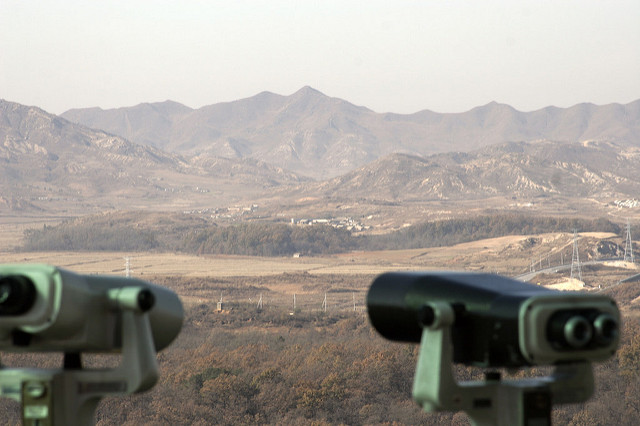
The North Korean missile test over the weekend has emphasised the point President Obama reportedly made to President-elect Trump shortly after his electoral success: North Korea should be at the top of the new President’s to-do list. Obama’s policy of “strategic patience” had run its course.
Since taking office, Kim Jong-un has consolidated power and raced ahead with developing a nuclear capability, testing two nuclear devices in 2016 alone. There are also indications that North Korea’s economy is starting to change; market forces have been allowed to play a role in the country’s economic recovery since the 1990s and, while estimates vary wildly, most point to at least positive GDP growth even under increasingly harsh economic sanctions.
But what’s perhaps been most surprising aspect has been the pace at which Pyongyang has been able progress the technologies in its missile and nuclear program since the Six-Party Talks were suspended in 2009. This recent chart from The Economist does a pretty good job of visualising the achievements (and failures) North Korea has made in its nuclear program. They include satellite launches, improvements in short- and medium-range ballistic missiles, and the beginnings of an SSBN program. It appears that the missile tested over the weekend is a land-based version of the solid-fuelled KN-11, a SLBM first tested in 2015. North Korean media has labelled this version of the missile the ‘Pukguksong-1.’
What’s been lost among the swirl of analysis and commentary about the test—and the ensuing controversy over how Trump’s team handled the briefing of the president and Prime Minister Abe during the incident—is that the Pukguksong-1 is solid-fuelled and comes with a tracked transporter-erector launcher (TEL).
That represents a notable climb up the missile-technology tree for North Korea and may well change deterrence dynamics on the Korean Peninsula.
To date, North Korea’s medium- and long-range missiles have used various forms of liquid rocket fuel, often highly unstable and difficult to handle. As liquid rocket fuel can’t be safely stored or kept in the missile during peacetime, such missiles can often take up to an hour to fuel and launch, making them vulnerable to attack and somewhat unreliable. Mobile liquid-fuelled rockets also require large and numerous logistic support vehicles to accompany the launcher, limiting how far off-road they can go and making their visual footprint from the air much harder to hide.
Solid-fuelled missiles solve some of those deficiencies. They can be launched within minutes, are far more reliable and don’t require as much supporting infrastructure. The new tracked TEL that goes along with the Pukguksong-1 opens up a significant amount of countryside in which to hide the mobile missiles. If Pyongyang continues with the systems development and eventually fits it with warheads, it will decrease any warning and decision-making time on the Peninsula during a crisis. Any full operational deployment of the missile system would certainly complicate efforts by the US and South Korea to continuously track North Korea’s nuclear forces. That makes a pre-emptive strike, even in a leadership decapitation scenario, much riskier.
While this new missile can’t reach the continental United States (its range is likely around 1,000km), it’s only a matter of time until North Korea crosses that line. We know they’ve been making progress on improved engines needed for multiple-staged ICBMs, and have demonstrated their ability to put a satellite into space. The last big hurdle seems to be mastering the re-entry.
The trip by Secretary of Defense Mattis to South Korea and Japan earlier this month has widely been seen as an ally-reassurance tour. But it’ll also feed into the North Korea policy review the White House is reported to be undertaking. The review will likely suggest some new policy options for the Trump administration in regards to North Korea. Advances in mobile, solid-fuelled missiles will make any potential military options unrealistic and difficult. Doubling down on ballistic missile defence is another option, but the Pukguksong-1 will even challenge THAAD. US Secretary of State Tillerson has flagged the possibility of ‘secondary sanctions’ on Chinese companies that violate UN Security Council sanctions on North Korea imposed last year in an effort to compel Beijing to bring these enterprises into line. That might work, but it’s likely such efforts will be too slow—it can take several years for sanctions to bite.
If the goal is to prevent North Korea from developing an ICBM, that really only leaves us with diplomacy. While restarting diplomatic negotiations with the DPRK would be difficult under any American administration after years of failed efforts, for the Trump administration it’s going to be an effort in prioritisation. Everyone, even Trump, knows that China is crucial in bringing North Korea to the table. And while the President’s recent back down on the ‘One China’ policy is a signal to some that he intends to pursue a more normalised relationship with Beijing, there’s still a strong sentiment across the administration (including in the Departments of Defense and State) and within the White House that the US needs to take a harder line with China across a range of longstanding issues, including trade, the South China Sea and Taiwan. Pressuring China on all fronts at once while also seeking a new way forward with North Korea seems incompatible at present. The Trump administration will need to decide where the DPRK stacks up against its broader China strategy.

